
Organic Chemistry Plus Masteringchemistry With Pearson Etext, Global Edition
9th Edition
ISBN: 9781292151229
Author: Wade, LeRoy G.
Publisher: PEARSON
expand_more
expand_more
format_list_bulleted
Concept explainers
Textbook Question
Chapter 15, Problem 15.40SP
Determine whether each structure is likely to be colored or not. For those that you predict to be colored, indicate the extended conjugation by marking the series of continuous sp2 hybridized atoms.
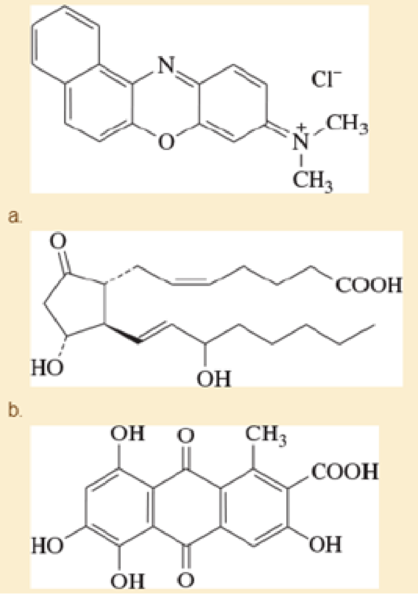
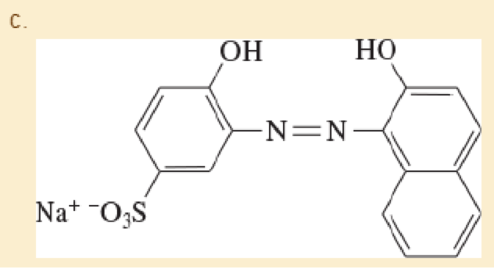
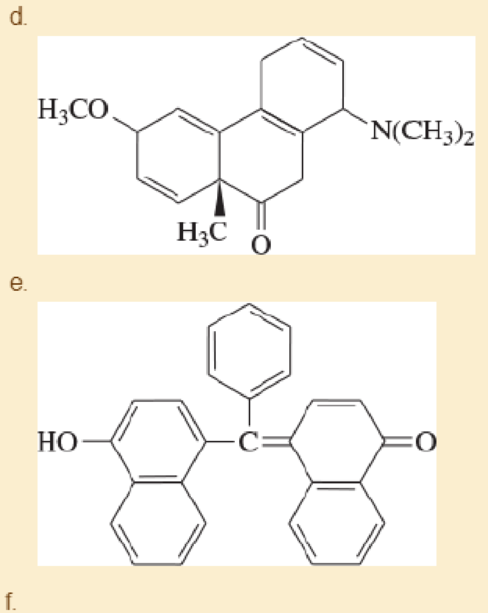
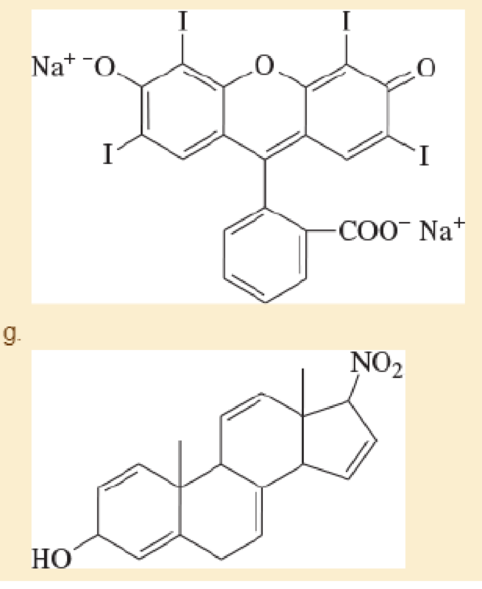
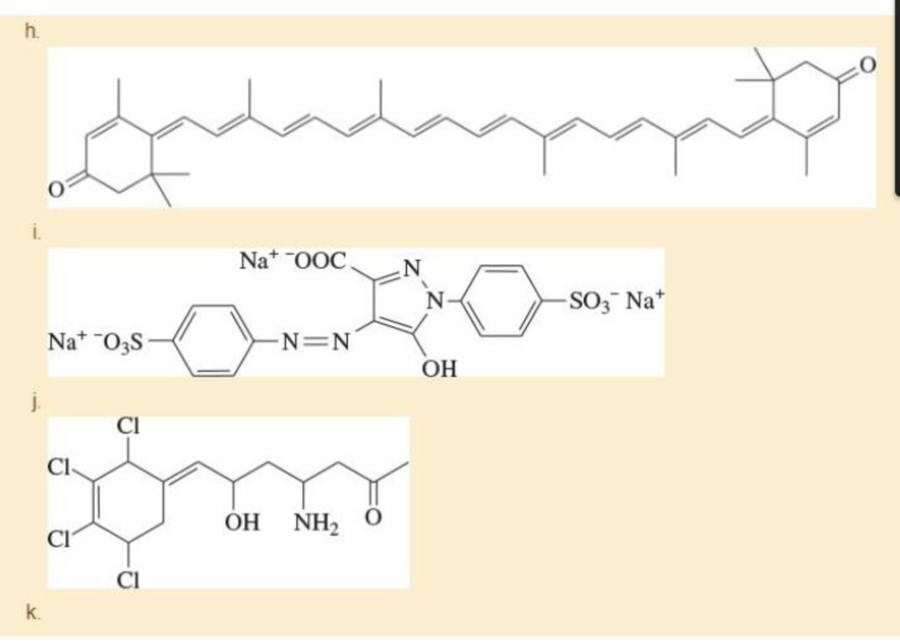
Expert Solution & Answer
Want to see the full answer?
Check out a sample textbook solution
Students have asked these similar questions
Considering the important roles of biothiols in lysosomes of live organisms, and unique photophysical / photochemical properties of ruthenium(II) complexes, a novel ruthenium(II) complex, Ru-2, has been developed as a molecular probe for phosphorescence and time-gated luminescence assay of biothiols in human sera, live cells, and in vivo. Ru-2 is weakly luminescent due to the effective photoinduced electron transfer (PET) from Ru(II) luminophore to electron acceptor, 2,4-dinitrobenzene-sulfonyl (DNBS). In the presence of biothiols, such as glutathione (GSH), cysteine (Cys), and homocysteine (Hcy), the emission of Ru-2 solution was switched ON, as a result of the cleavage of quencher to form the product, Ru-1. Ru-2 showed high selectivity and sensitivity for the detection of biothiols under physiological conditions, with detection limits of 62 nM, 146 nM, and 115 nM for GSH, Cys, and Hcy, respectively. The emission lifetimes of Ru-1 and Ru-2 were measured to be 405 and 474 ns,…
In an effort to reduce costs and increase the accessibility of instruments that utilize spectrophotometric detection, some researchers are beginning to experiment with 3D-printed parts. One example of this is the 3D-printed flow cell, shown at right. This device was made using polylactic acid and accommodates a LED at one end and a detector at the other. It can be used for standalone flow injection spectrophotometry or coupled to a chromatographic separation to be used as a detector.
Explain why the sensitivity varies with the length of the flow cell, as shown in the data below.
Could this setup be used for fluorescence analysis? Why or why not?
The dark lines in the solar spectrum were discovered by Wollaston and cataloged by Fraunhofer in the early days of the 19th century. Some years later, Kirchhoff explained the appearance of the dark lines: the sun was acting as a continuum light source and metals in the ground state in its atmosphere were absorbing characteristic narrow regions of the spectrum. This discovery eventually spawned atomic absorption spectrometry, which became a routine technique for chemical analysis in the mid-20th century. Laboratory-based atomic absorption spectrometers differ from the original observation of the Fraunhofer lines because they have always employed a separate light source and atomizer. This article describes a novel atomic absorption device that employs a single source, the tungsten coil, as both the generator of continuum radiation and the atomizer of the analytes. A 25-μL aliquot of sample is placed on the tungsten filament removed from a commercially available 150-W light bulb. The…
Chapter 15 Solutions
Organic Chemistry Plus Masteringchemistry With Pearson Etext, Global Edition
Ch. 15.2 - Prob. 15.1PCh. 15.2 - Prob. 15.2PCh. 15.2 - Prob. 15.3PCh. 15.4 - Prob. 15.4PCh. 15.4 - Prob. 15.5PCh. 15.5 - Treatment of an alkyl halide with AgNO3 in alcohol...Ch. 15.5 - Propose a mechanism for each reaction, showing...Ch. 15.6 - When Br2 is added to buta-1,3-diene at 15 C, the...Ch. 15.7 - Prob. 15.9PCh. 15.7 - When N-bromosuccinimide is added to hex-1-ene in...
Ch. 15.7 - Prob. 15.11PCh. 15.9 - Addition of 1-bromobut-2-ene to magnesium metal in...Ch. 15.10 - Show how you might synthesize the following...Ch. 15.11 - Predict the products of the following proposed...Ch. 15.11 - Prob. 15.15PCh. 15.11A - Prob. 15.16PCh. 15.11B - Prob. 15.17PCh. 15.11B - Predict the products of the following Diels-Alder...Ch. 15.12C - Prob. 15.19PCh. 15.12C - Prob. 15.20PCh. 15.13C - Prob. 15.21PCh. 15.13D - Using the examples in Table15-2 to guide you,...Ch. 15.14 - Phenolphthalein is an acid-base indicator that is...Ch. 15 - Prob. 15.24SPCh. 15 - Prob. 15.25SPCh. 15 - Show how the reaction of an allylic halide with a...Ch. 15 - Prob. 15.27SPCh. 15 - A solution was prepared using 0.0010 g of an...Ch. 15 - Prob. 15.29SPCh. 15 - Prob. 15.30SPCh. 15 - Prob. 15.31SPCh. 15 - Prob. 15.32SPCh. 15 - Prob. 15.33SPCh. 15 - Give the structures of the products represented by...Ch. 15 - Furan and malemide undergo a Diels-Alder reaction...Ch. 15 - Prob. 15.36SPCh. 15 - Prob. 15.37SPCh. 15 - Prob. 15.38SPCh. 15 - Prob. 15.39SPCh. 15 - Determine whether each structure is likely to be...Ch. 15 - An important variation of the Diels-Alder reaction...
Knowledge Booster
Learn more about
Need a deep-dive on the concept behind this application? Look no further. Learn more about this topic, chemistry and related others by exploring similar questions and additional content below.Similar questions
- Challenging samples: 1. Metal complexes with low volatility are often difficult to analyze when performing atomic absorption measurements because the atomization efficiency is reduced to unacceptably low levels. Devise a strategy or strategies for eliminating the problem of a non-volatile metal complex? Explain how you would do that. 2. Devise a strategy to overcome unwanted ionization of the analyte? Explain what it would be. 3. Devise a general method that can be used to account for the presence of unknown matrix effects.arrow_forwardDon't used hand raitingarrow_forwardDon't used hand raiting don't used Ai solutionarrow_forward
- Homework: Atomic Structure This homework is due at the beginning of class next lecture period and is worth 6 points. Please place the number of protons and neutrons in the nucleus and then put the number of electrons in the correct shell. Also give the correct atomic mass. Also, state if the atom is an ion (cation or anion). H* 1. Number of protons Number of electrons Number of neutrons Atomic mass 2. 26 13AI +++ Number of protons Number of neutrons Number of electrons Atomic massarrow_forwardDon't used hand raitingarrow_forwardI need help working this problem out step by step, I was trying to use my example from the txt book but all I know how to do is set it up. I need to be shown step by step as I am a visual learner. Please help me.arrow_forward
- Don't used hand raitingarrow_forwardDon't used Ai solution and don't used hand raitingarrow_forward& Calculate the molar enthalpy of combustion (A combH) of 1.80 g of pyruvic acid (CH3COCOOH; 88.1 g mol-1) at 37 °C when they are combusted in a calorimeter at constant volume with a calorimeter constant = 1.62 kJ °C-1 and the temperature rose by 1.55 °C. Given: R = 8.314 J mol −1 °C-1 and the combustion reaction: AN C3H4O3 + 2.502(g) → 3CO2(g) + 2H2O(l)arrow_forward
arrow_back_ios
SEE MORE QUESTIONS
arrow_forward_ios
Recommended textbooks for you
 Organic Chemistry: A Guided InquiryChemistryISBN:9780618974122Author:Andrei StraumanisPublisher:Cengage Learning
Organic Chemistry: A Guided InquiryChemistryISBN:9780618974122Author:Andrei StraumanisPublisher:Cengage Learning Principles of Modern ChemistryChemistryISBN:9781305079113Author:David W. Oxtoby, H. Pat Gillis, Laurie J. ButlerPublisher:Cengage Learning
Principles of Modern ChemistryChemistryISBN:9781305079113Author:David W. Oxtoby, H. Pat Gillis, Laurie J. ButlerPublisher:Cengage Learning Organic ChemistryChemistryISBN:9781305580350Author:William H. Brown, Brent L. Iverson, Eric Anslyn, Christopher S. FootePublisher:Cengage Learning
Organic ChemistryChemistryISBN:9781305580350Author:William H. Brown, Brent L. Iverson, Eric Anslyn, Christopher S. FootePublisher:Cengage Learning

Organic Chemistry: A Guided Inquiry
Chemistry
ISBN:9780618974122
Author:Andrei Straumanis
Publisher:Cengage Learning

Principles of Modern Chemistry
Chemistry
ISBN:9781305079113
Author:David W. Oxtoby, H. Pat Gillis, Laurie J. Butler
Publisher:Cengage Learning

Organic Chemistry
Chemistry
ISBN:9781305580350
Author:William H. Brown, Brent L. Iverson, Eric Anslyn, Christopher S. Foote
Publisher:Cengage Learning
INTRODUCTION TO MOLECULAR QUANTUM MECHANICS -Valence bond theory - 1; Author: AGK Chemistry;https://www.youtube.com/watch?v=U8kPBPqDIwM;License: Standard YouTube License, CC-BY